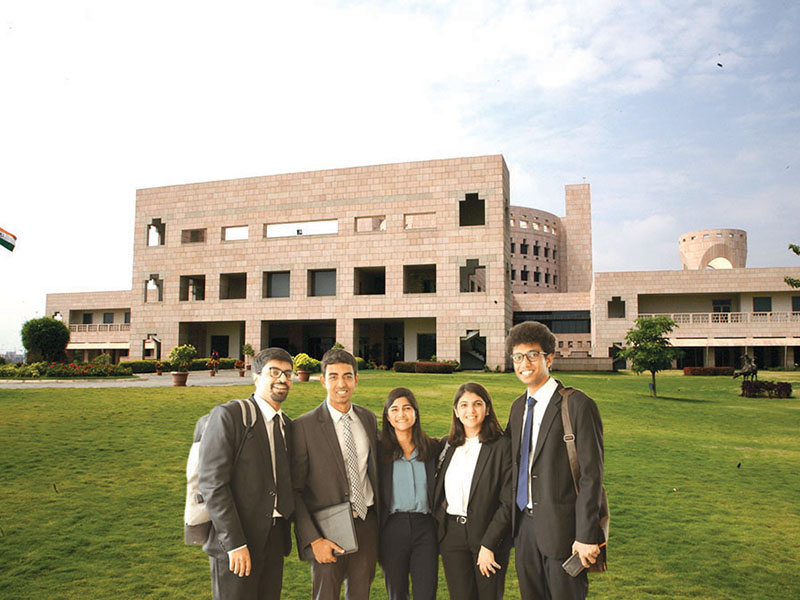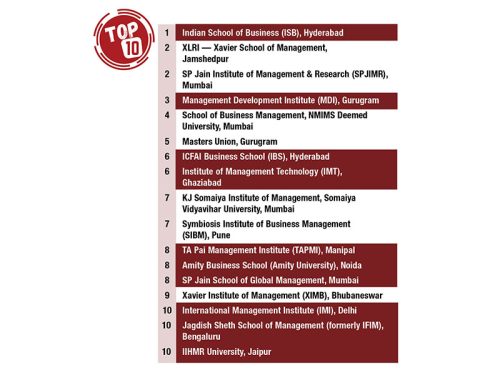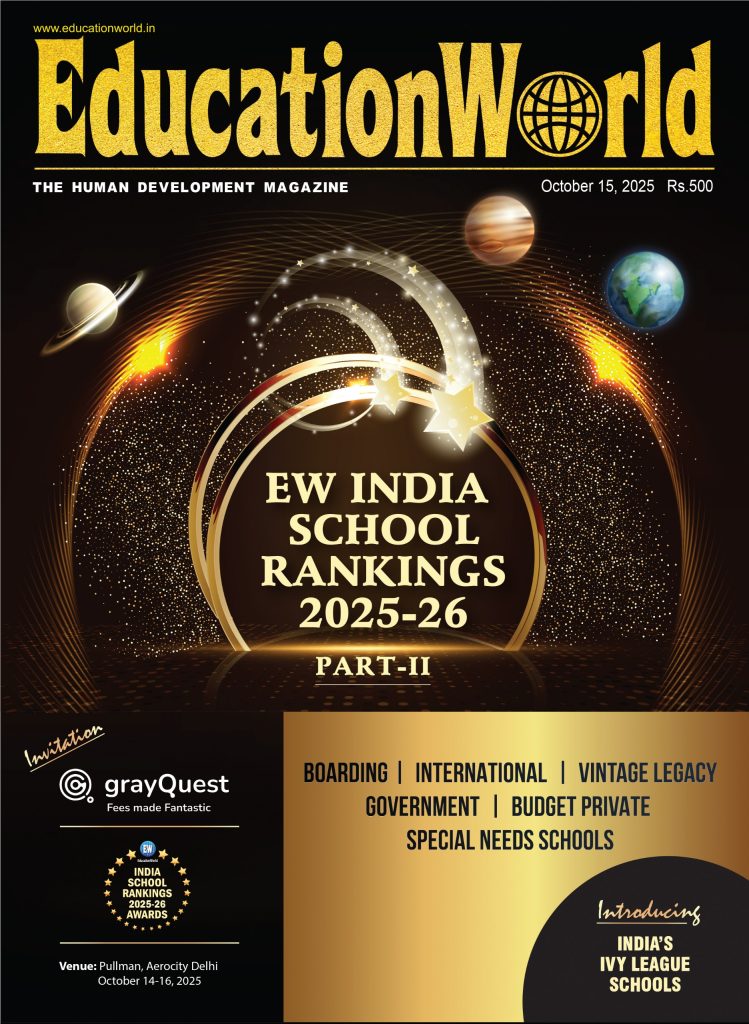EWIHER 2024-25: India’s Top 100 Private B-Schools
India’s private B-schools capable of responding quickly to changes in the business environment and customising their curriculums accordingly, are likely to play an increasingly important role to modernise and upgrade India Inc to compete with the world’s most dominant corporations, writes Dilip Thakore

Indian School of Business: Financial Times, London global #31
 If India’s estimated 5,000 business management institutes, aka B-schools — some of them of over half century vintage — were half as good as they claim to be, the Indian economy would be booming and 21st century India would not be in the bottom rung of economic development league tables including the World Bank’s per capita income, UNDP’s Human Development and the World Economic Forum’s industrial progress indices. Although politicians of all shades and hues proclaim it a developed country, the plain truth is that 77 years after attaining independence from foreign rule, India is routinely ranked among the world’s poorest and backward nations defined by acute shortages of food, clothing, shelter, affordable healthcare and education.
If India’s estimated 5,000 business management institutes, aka B-schools — some of them of over half century vintage — were half as good as they claim to be, the Indian economy would be booming and 21st century India would not be in the bottom rung of economic development league tables including the World Bank’s per capita income, UNDP’s Human Development and the World Economic Forum’s industrial progress indices. Although politicians of all shades and hues proclaim it a developed country, the plain truth is that 77 years after attaining independence from foreign rule, India is routinely ranked among the world’s poorest and backward nations defined by acute shortages of food, clothing, shelter, affordable healthcare and education.
Obviously, the nasty, brutish and perhaps too long lives that the overwhelming majority of Indian citizens are obliged to endure, can’t be the fault of the country’s B-schools. However some blame for none of India’s companies being listed among the largest, most respected, competitive and innovative, must surely be laid at their door. Some, but not all because the prime cause of the backwardness of India Inc is socialist ideology foolishly imposed upon newly independent India by the Congress party which remained in government at the Centre and most states of the country for over half a century.
Under the “socialist pattern of society”, India’s 256 Central government PSEs and an equal number promoted by state governments failed to generate the surpluses for investment in infrastructure, public health and education. Simultaneously bound up in red tape India’s high-potential private sector companies failed to grow and prosper and were surpassed by Japanese, Korean and latterly Chinese private corporations.
Against this backdrop, India’s first B-school, the Indian Institute of Management-Calcutta (IIM-C) was established in 1961 with American funding and grudgingly permitted collaboration with the MIT’s Sloan School of Management (USA). IIM-C was soon followed by IIM-Ahmedabad and IIM-Bangalore.
Yet the contribution of these three premier IIMs to the national development effort remained hazy until the advent of the country’s first business magazines — Business India and BusinessWorld — made private enterprise respectable and shone a spotlight on these capital-intensive B-schools which certified 200-300 MBAs annually.
Suddenly the two-year wholly residential MBA programmes of the IIMs became very popular and 50,000-100,000 candidates started writing CAT (Common Admission Test) of the IIMs whose number has since multiplied to 21 countrywide. Moreover with the increasing liberalisation of the shackled Indian economy which averaged a pitiful GDP growth of 3.5 percent per annum for over 40 years, several other B-schools mushroomed all over the country providing good, bad and indifferent business management education to an ever increasing number of students.
In 2013, we introduced the EducationWorld India Higher Education Rankings (EWIHER). The annual EWIHER inter alia also rated and ranked India’s most admired B-schools in a separate, dedicated category. But with the IIMs dominating the initial EW B-school league tables (and all media rankings), and bearing in mind that they admit a mere 2 percent of MBA aspirants, in 2016 we stopped ranking IIMs and government B-schools and focused on ranking privately promoted business education institutions which admit the overwhelming majority of college graduates signing up for B-school education.
Since then, the EW league table of private B-schools has been dominated by the Indian School of Business, Hyderabad (ISB) funded in 2002 by several of the biggest names of India Inc – Ambani, Godrej, Bajaj and Rajat Gupta (McKinsey, New York) — on a 260-acre state-of-the art campus in Gachibowli, suburban Hyderabad.
And over the past almost quarter century since this private B-school was promoted with a reported endowment of Rs.250 crore, ISB has built an excellent reputation for providing globally comparable business management education to its students obliged to fork out Rs.33-35 lakh for its 13-month fully residential MBA programme. In effect, this tuition fee is double that of the top IIMs which after decades of over-subidisation currently levy an equivalent fee for their two-year MBA programmes.
According to ISB spokespersons, this huge (by Indian standards) tuition fee is justified because of its partnerships with top ranked B-schools worldwide, and its global #31 Financial Times (London) ranking.
Although its FT rank is above IIM-Ahmedabad (#41), IIM-Bangalore (47) and IIM-Calcutta (67), it is pertinent to note that ISB is not Asia’s premier B-school according to the FT 2024 league table of the world’s Top 100 B-schools. Shanghai University of Finance & Economics College of Business (#24), the National University of Singapore’s B-school (#27) and the Fudan School of Management (#27) are ranked higher. However, despite the distinguished alumni proclaimed on its website unlikely to set the Ganges on fire, on the index of hubris, insolence of office, proud man’s contumely etc, ISB is likely to be ranked #1 worldwide.

Masters Union co-founders Pratham Mittal & Swati Ganetti (left): encouraging debut
Although ISB dean Dr. Madan Pillutla has received the benefit of excellent education in BITS, Pilani; XLRI, Jamshedpur; University of Illinois; and a Ph D from the University of British Columbia, he is evidently innocent of the image building advantage ISB could derive from disseminating the success story and future plans of the blue-chip B-school he heads. Numerous emails, phone calls and letters to his office and to ISB’s public relations agency yielded no response.
In this year’s EW league table of India’s best private B-schools, there’s been minor rearrangement of seating at top table. ISB, Hyderabad is followed by XLRI – Xavier School of Management, Jamshedpur at #2 (2), S.P. Jain Institute of Management & Research, Mumbai promoted to #2 (3); MDI, Gurugram #3 and NMIMS School of Business Management, Mumbai #4. However the previously unranked Masters Union, Gurugram (estb. 2020) — a new age B-school — has made a spectacular debut in top table at #5 with excellent scores under the parameters of competence of faculty, research, curriculum & pedagogy and industry interface. Moreover the Jagdish Sheth School of Management, Bengaluru (formerly IFIM) has made an impressive leap forward into the Top 10 league table.
Swati Ganetti, an alumna of IIT-Delhi and the Wharton School of Business (USA) who began her career in the Delhi office of US-based consulting major Bain & Co and served with several edtech start-ups prior to co-promoting Masters Union with Pratham Mittal, also a Wharton alum, is “super glad” that the “very young” MU is ranked among the country’s Top 5 private B-schools.
“The differentiating feature of MU is that we don’t recruit full-time academic faculty. Unlike other B-schools all our classes are conducted by over 200 industry leaders who constitute visiting faculty. Therefore given this feature of MU, I’m not surprised that we have been awarded a high score under the parameter of faculty competence. Our close industry connect also explains our high score for industry interface and placement. Moreover our good score under the research parameter is also very encouraging. I am very pleased with our debut in the EW league table,” says Ganetti. Currently, this new B-school has 350 students and 16 full-time faculty on its muster rolls.

SPJSGM’s Nitish Jain (centre): unique global programmes
Another low-profile, differentiated B-school with a unique globalised study programme which has risen high in the esteem of the informed public is the S.P Jain School of Global Management (SPJSGM, estb. 2004). Ranked #12 in 2023-24, it is promoted to the Top 10 table with #8 rank this year. The defining character of SPJSGM is that in India, it offers only a four-year BBA (bachelor of business administration) degree programme. Under this programme, students are taught business management in India for one year and are obliged to attend classes in any one or more of SPJSGM’s campuses in Singapore, Dubai, Sydney and London. The school’s 18-month MBA programme open to students with three years’ corporate experience is provided in campuses abroad.
“I am somewhat surprised that it has taken so long for SPJSGM to make it into your Top 10 table of India’s best B-schools. But this may be because most of our students are learning in our campuses abroad where we are routinely high ranked by Forbes, Bloomsberg and Wall Street Journal and other well-reputed print publications. However, SPJSGM is the only Indian B-school with more campuses abroad than in India. This is because it was promoted in anticipation of an increasingly globalised world of business and commerce. Our USP is that our graduates are familiarized with Indian business mores as well as cultures of other countries of their choice. Because of our internationalism, SPJSGM deserves better scores under the parameters of curriculum and pedagogy and research than we have been awarded,” says Nitish Jain, a business management graduate of Cornell University, USA, and Founder-President. Currently, SPJSGM has an aggregate 3,000 undergrad and postgraduate students in its five campuses mentored by 65 full-time and 150 visiting faculty.
In the mainly status quo 2024-25 league table of India’s most admired private B-schools, an institute which specialises in training students for an important but relatively neglected health management sector of the Indian economy is the Jaipur-based IIHMR University, Jaipur (estb. 1984) awarded university status. Unranked until 2023-24 when it debuted at #14, this year IIHMR is ranked co-ranked #10 with high scores under infrastructure, placement and leadership.

IIHMR’s Founder-President Prof. P.R. Sodani (centre): experiential learning opportunities
We are thrilled and honoured that IIHMR University, Jaipur is ranked among India’s Top 10 private B-schools, and #1 in Rajasthan. This is an important milestone in our journey towards becoming a globally renowned institution in the field of health management,” says Dr. P.R. Sodani, an alum of the University of North Carolina at Chapel Hill, USA and co-founder and President of IIHMR.
Dr. Sodani attributes the upward mobility in institutional ranking charts to the institute’s high quality faculty comprising experts in hospital and lab management, strong industry interface and clearly defined curriculums that provide experiential learning opportunities for students to bridge the academia-industry gap. “Moreover, IIHMR’s robust infrastructure comprising state-of-the-art classrooms, laboratories, well-equipped libraries and recreational facilities, provides a conducive environment for learning, research, and innovation, contributing to the growth and development of our faculty and students. Looking into the future, we intend to expand our global footprint through international collaborations, exchange programs, and partnerships with leading institutions worldwide,” says Sodani. Currently, IIHMR has 800 students mentored by 45 faculty on its muster rolls.
Beyond the Top 10, among the private B-schools that have improved their ranking this year are the N.L Dalmia Institute of Management Studies & Research, Mumbai ranked #16 (cf. #18 in 2023-24); previously unranked Vijay Patil School of Management, Navi Mumbai debuting at #17; Jaipuria Institute of Management, Lucknow #18 (21); JK Business School, Gurugram #20 (25); the previously unranked ASM Institute of Business Management & Research, Pune at #25; Chitkara Business School, Patiala #25 (35); Heritage Business School, Kolkata #28 (31) and Jindal Global Business School #32 (34).
India’s private B-schools which are capable of responding quickly to changes in the business environment and customise their curriculums accordingly, are likely to play an increasingly important role in developing managers and executives required to rapidly modernise and upgrade India Inc to collaborate and compete with the world’s most go-getting and dominant corporations. Therefore, it’s important to note that B-schools that are modestly ranked in the national league table, are not necessarily also-rans. In their host states — some of whom are more populous than many European countries, they are highly regarded.
For instance the Institute of Management of Nirma University, Ahmedabad ranked #24 nationally is #1 in Gujarat (pop.71.6 million). Likewise the School of Business Management of NMIMS University, Indore ranked India #33 is top ranked in Madhya Pradesh (pop.87 million) and Chitkara Business School, Patiala ranked India #25 is #1 in Punjab (pop.31 million). Therefore all B-schools listed in the EW league table 2024-25 need to be given utmost respect and encouragement to improve and upgrade into world-class institutions capable of nurturing high-quality human resources required to transform India’s business enterprises into globally competitive corporations.
Also read: India’s Top 100 Private B-Schools 2021-22

















Add comment